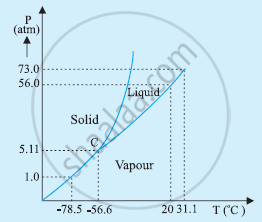Advertisements
Advertisements
प्रश्न
Answer the following questions based on the P–T phase diagram of CO2:
CO2 at 1 atm pressure and temperature – 60 °C is compressed isothermally. Does it go through a liquid phase?
उत्तर १
No
The P-T phase diagram for CO2 is shown in the following figure.

At 1 atm pressure and at –60°C, CO2 lies to the left of –56.6°C (triple point C). Hence, it lies in the region of vaporous and solid phases.
Thus, CO2 condenses into the solid state directly, without going through the liquid state
उत्तर २
No, the CO2 does not go through the liquid phase. The point (1.00 atm, – 60°C) is to the lift of the triple-point O and below the sublimation curve OA. Therefore, when CO2 is compressed at this point at constant temperature, the point moves perpendicular to the temperature-axis and enters the solid phase region. Hence, the CO2 vapour condenses to solid directly without going through the liquid phase.
APPEARS IN
संबंधित प्रश्न
Answer the following question based on the P-T phase diagram of carbon dioxide:
Is CO2 solid, liquid or gas at
- –70 °C under 1 atm,
- –60 °C under 10 atm,
- 15 °C under 56 atm?
Answer the following questions based on the P–T phase diagram of CO2:
What happens when CO2 at 4 atm pressure is cooled from room temperature at constant pressure?
Answer the following questions based on the P–T phase diagram of CO2:
Describe qualitatively the changes in a given mass of solid CO2 at 10 atm pressure and temperature –65 °C as it is heated up to room temperature at constant pressure.
Answer the following questions based on the P–T phase diagram of CO2:
Describe qualitatively the changes in a given mass of solid CO2 at 10 atm pressure and temperature –65 °C as it is heated up to room temperature at constant pressure.
A brass boiler has a base area of 0.15 m2 and thickness 1.0 cm. It boils water at the rate of 6.0 kg/min when placed on a gas stove. Estimate the temperature of the part of the flame in contact with the boiler. The thermal conductivity of brass = 109 J s –1 m–1 K–1; Heat of vaporisation of water = 2256 × 103 J kg–1.
Explain why a body with large reflectivity is a poor emitter
A metal block of heat capacity 80 J°C−1 placed in a room at 20°C is heated electrically. The heater is switched off when the temperature reaches 30°C. The temperature of the block rises at the rate of 2°C s−1 just after the heater is switched on and falls at the rate of 0.2°C s−1 just after the heater is switched off. Assume Newton's law of cooling to hold.
- Find the power of the heater.
- Find the power radiated by the block just after the heater is switched off.
- Find the power radiated by the block when the temperature of the block is 25°C.
- Assuming that the power radiated at 25°C represents the average value in the heating process, find the time for which the heater was kept on.
Answer the following question based on the P-T phase diagram of carbon dioxide:
What are the critical temperature and pressure for CO2? What is their significance?
During summers in India, one of the common practice to keep cool is to make ice balls of crushed ice, dip it in flavoured sugar syrup and sip it. For this a stick is inserted into crushed ice and is squeezed in the palm to make it into the ball. Equivalently in winter, in those areas where it snows, people make snow balls and throw around. Explain the formation of ball out of crushed ice or snow in the light of P–T diagram of water.
100 g of water is supercooled to –10°C. At this point, due to some disturbance mechanised or otherwise some of it suddenly freezes to ice. What will be the temperature of the resultant mixture and how much mass would freeze?
`[S_w = 1cal/g/^circC and L_(Fusion)^w = 80cal/g]`
